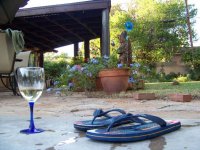Water pressure....
Is no one thinking of the mass amount of pressure water would put on the speaker?? You'd need something extremely rigid to get it to move without distortion. Not to mention an enormous amount of power. My advice is don't put it very deep if you can help it.
Maybe some sort of hydraulic piston?
Is no one thinking of the mass amount of pressure water would put on the speaker?? You'd need something extremely rigid to get it to move without distortion. Not to mention an enormous amount of power. My advice is don't put it very deep if you can help it.
Maybe some sort of hydraulic piston?
You attach them to a thin panel that needs studs to stand above ground. On the panel you place the pool. The panel will work as a membrane with a big surface to project as much vibration into the water...Mount those bass shaker transducers to the outside of the pool (above ground)?
Sorry Oliver, couldn't resist

How about a pair of very long, large front loaded horns with any electrical components well above the floor(make it double as a diving board mount maybe  )??
)??
Load it with some 15" drivers
Heck, if you build the pool yourself, make the pool BE the mouth of the horn
Load it with some 15" drivers
Heck, if you build the pool yourself, make the pool BE the mouth of the horn
Last edited:
Is no one thinking of the mass amount of pressure water would put on the speaker?? You'd need something extremely rigid to get it to move without distortion. Not to mention an enormous amount of power. My advice is don't put it very deep if you can help it.
...
There would be no pressure if you did it right. You just need to equalise the pressure inside and outside the cabinet. This could be a simple as a flexible bladder inside the cabinet, allowing water into the bladder would compress the air until the pressures were equal. Or you could use something complicated like an air compresser, as is used for divers in diving bells and suits.
So instead of moving air with density of 1.2 kg/m3 and acoustic impedance of 413.3 N·s·m−3 you want to move water with density of 1000 kg/m3 and practically incompressible?
You would need a coil that moves 830 times less, but with 830 times more pressure.
It's not actually that bad. Speaker drivers are very inefficient. The coupling between the cone and the air is very poor because the cone is so much heavier than the air it is moving. You can see this in the mmd and mms specifications for a driver - one is the mass of the cone in a vacuum, the other is the effective mass with the mass of the air it interacts with added. The higher the mass of the medium (air or water) is compared with the mass of the cone, the more efficient the speaker will be.
You will need linear excursion which automatic leads to more heavy cone materials. So only piezoelectric driven transducers and fan based transducers will be able to deliver the force necessary for producing LF in water. Fan is out of the question because for safety reasons you can't use more then 30Volts in water (NEN-standard). That would needs large amounts of amps to deliver enough energy to make the fan turn around, not very practical.
Second problem you all seem to forget is the wavelength problem. We all know 50Hz in air has a wavelength of 6,8meter. How you want to fit a 50Hz wave in a backyard swimming pool when the wavelength is 30 meter (speed in water is 1500m/s) ???
???
Second problem you all seem to forget is the wavelength problem. We all know 50Hz in air has a wavelength of 6,8meter. How you want to fit a 50Hz wave in a backyard swimming pool when the wavelength is 30 meter (speed in water is 1500m/s)
Last edited:
Depends on the pool sides. If they are reflective (hard/sturdy and high mass surface) it is a problem. If they are like air filled rubber tubes, it is not a big problem. In that case it would look like car acoustics but without the gain factor in Low Frequency. Instead I think it will look more like a nice and steady roll-off. Also don't forget the 30Volt safety! With an 8Ohm driver that means max 112Watts.Is the wavelength problem really that big of a deal?
Imo, the excursion is the last thing to worry. Like Don already stated in water you'll need less excursion to deliver the same acoustic energy compared to air. So far he is absolutely right. The pressure mentioned earlier is also not a problem since both sides of the cone face equal pressure. The problem is the mass and damping of the water. The traditional motor and cone suspension structure are not able to cope with the high mass and damping of the water. That's why all under-water loudspeakers are piezo-element driven in combination with a very stiff suspension and a hard surface cone. Otherwise you'll end up with a few peaks here and there in the audio band which looks everything but like a music signal. The stiff suspension and hard cone you need to generate a linear signal. The lower in frequency the tougher it gets to keep the signal linear. Above 500Hz maybe you would get away with a traditional driver structure (and anon linear response) but below that, forget it. No traditional driver is able to deliver such thing under water, even if you could make them 100% waterproof in the first place.And could a normal 15 inch driver with 1.5 inches of excursion do the job? I guess I don't see why the cone needs to be so heavy.
Last edited:
I guess I'll just have to test it. The plan: small 3-way speaker (5 inch woofer) salvaged from a defunct 3-in-1 music system. Wrapped in heavy plastic pulled just tight enough so that when placed face down in the water, the plastic does not touch the cone. Run a nice hot bath, place the box face down in the water and feed it audio. Lie down in the bath with my ears underwater.
That's what I love about DIY, nuts enough to do whatever is necessaryI guess I'll just have to test it. The plan: small 3-way speaker (5 inch woofer) salvaged from a defunct 3-in-1 music system. Wrapped in heavy plastic pulled just tight enough so that when placed face down in the water, the plastic does not touch the cone. Run a nice hot bath, place the box face down in the water and feed it audio. Lie down in the bath with my ears underwater.
1/. Make a standard sealed subwoofer enclosure. You may be able to get away with a smaller than usual box. Make the box shallow - wide and tall, but minimum depth front to back. Smooth the outside of the enclosure - no sharp or jagged edges.
2/. Put the box in a heavy (thick) plastic bag. The bag should be sized and pulled tight enough that the plastic is slightly loose across the driver opening, but not so loose that you can push it against the driver cone. Align the enclosure "face down" in the bag so that the bag closure (opening) is at the back of the enclosure, with the wire coming out. Airtightness is not essential, but tie it as tight as you can.
3/. Place the enclosure in the pool so that it floats face down. Feed it some bass. Job done...
I would try something like this to see if it is even worth continuing with this concept. Its not hard to find a cheap woofer, build a box and find a thick plastic bag. Maybe one of those vacuum storage bags would be thick enough. It is sound ok with this setup then I would try making something more permanent.
A wild stab in the dark...
I'm thinking something like a 4th order bandpass box, but a passive radiator instead of a port out the front. Make it a big passive radiator. Some kind of thick, water-proof stuff.
Drive it (from the air side) from a decent 15" subwoofer. Or two. The point is that the PR should have several times the surface area of the drivers. That way, it won't move very far, when the subs are really going for it. It will, I suspect, move with much more force, though.
Might be a rubbish idea, but thought I'd throw it out there.
Chris
I'm thinking something like a 4th order bandpass box, but a passive radiator instead of a port out the front. Make it a big passive radiator. Some kind of thick, water-proof stuff.
Drive it (from the air side) from a decent 15" subwoofer. Or two. The point is that the PR should have several times the surface area of the drivers. That way, it won't move very far, when the subs are really going for it. It will, I suspect, move with much more force, though.
Might be a rubbish idea, but thought I'd throw it out there.
Chris
I guess I'll just have to test it. The plan: small 3-way speaker (5 inch woofer) salvaged from a defunct 3-in-1 music system. Wrapped in heavy plastic pulled just tight enough so that when placed face down in the water, the plastic does not touch the cone. Run a nice hot bath, place the box face down in the water and feed it audio. Lie down in the bath with my ears underwater.
It would work better if you let the plastic touch the woofer. If the woofer was a piston, better yet. You're going to have impedance matching problems if the woofer is not actually moving water, but moving air, which is then moving water.
Your version can be tested at a pool party without any special gear. Just dive in and listen.
- Status
- This old topic is closed. If you want to reopen this topic, contact a moderator using the "Report Post" button.
- Home
- Loudspeakers
- Subwoofers
- Subwoofer design to vibrate water in a pool?
